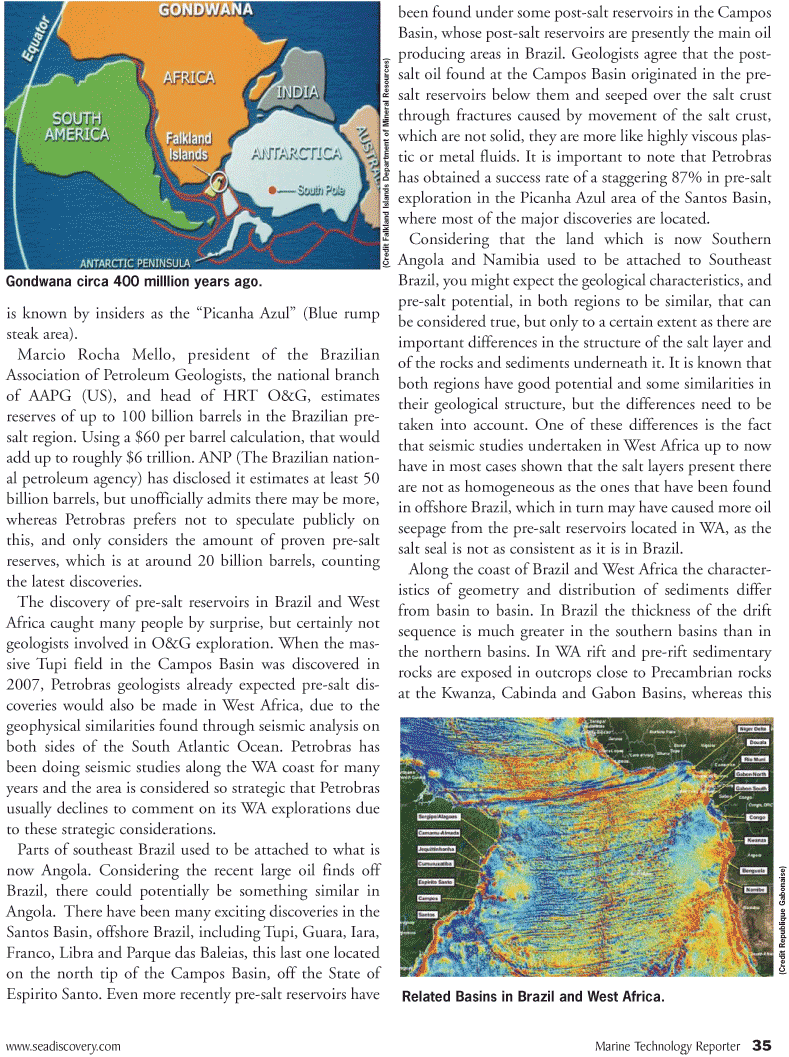
Page 35: of Marine Technology Magazine (September 2010)
Ocean Observation
Read this page in Pdf, Flash or Html5 edition of September 2010 Marine Technology Magazine
www.seadiscovery.com Marine Technology Reporter 35 is known by insiders as the “Picanha Azul” (Blue rump steak area).
Marcio Rocha Mello, president of the Brazilian
Association of Petroleum Geologists, the national branch of AAPG (US), and head of HRT O&G, estimates reserves of up to 100 billion barrels in the Brazilian pre- salt region. Using a $60 per barrel calculation, that would add up to roughly $6 trillion. ANP (The Brazilian nation- al petroleum agency) has disclosed it estimates at least 50 billion barrels, but unofficially admits there may be more, whereas Petrobras prefers not to speculate publicly on this, and only considers the amount of proven pre-salt reserves, which is at around 20 billion barrels, counting the latest discoveries.
The discovery of pre-salt reservoirs in Brazil and West
Africa caught many people by surprise, but certainly not geologists involved in O&G exploration. When the mas- sive Tupi field in the Campos Basin was discovered in 2007, Petrobras geologists already expected pre-salt dis- coveries would also be made in West Africa, due to the geophysical similarities found through seismic analysis on both sides of the South Atlantic Ocean. Petrobras has been doing seismic studies along the WA coast for many years and the area is considered so strategic that Petrobras usually declines to comment on its WA explorations due to these strategic considerations.
Parts of southeast Brazil used to be attached to what is now Angola. Considering the recent large oil finds off
Brazil, there could potentially be something similar in
Angola. There have been many exciting discoveries in the
Santos Basin, offshore Brazil, including Tupi, Guara, Iara,
Franco, Libra and Parque das Baleias, this last one located on the north tip of the Campos Basin, off the State of
Espirito Santo. Even more recently pre-salt reservoirs have been found under some post-salt reservoirs in the Campos
Basin, whose post-salt reservoirs are presently the main oil producing areas in Brazil. Geologists agree that the post- salt oil found at the Campos Basin originated in the pre- salt reservoirs below them and seeped over the salt crust through fractures caused by movement of the salt crust, which are not solid, they are more like highly viscous plas- tic or metal fluids. It is important to note that Petrobras has obtained a success rate of a staggering 87% in pre-salt exploration in the Picanha Azul area of the Santos Basin, where most of the major discoveries are located.
Considering that the land which is now Southern
Angola and Namibia used to be attached to Southeast
Brazil, you might expect the geological characteristics, and pre-salt potential, in both regions to be similar, that can be considered true, but only to a certain extent as there are important differences in the structure of the salt layer and of the rocks and sediments underneath it. It is known that both regions have good potential and some similarities in their geological structure, but the differences need to be taken into account. One of these differences is the fact that seismic studies undertaken in West Africa up to now have in most cases shown that the salt layers present there are not as homogeneous as the ones that have been found in offshore Brazil, which in turn may have caused more oil seepage from the pre-salt reservoirs located in WA, as the salt seal is not as consistent as it is in Brazil.
Along the coast of Brazil and West Africa the character- istics of geometry and distribution of sediments differ from basin to basin. In Brazil the thickness of the drift sequence is much greater in the southern basins than in the northern basins. In WA rift and pre-rift sedimentary rocks are exposed in outcrops close to Precambrian rocks at the Kwanza, Cabinda and Gabon Basins, whereas this
Gondwana circa 400 milllion years ago. (Cr edit Falkland Islands Depar tment of Mineral Resour ces)
Related Basins in Brazil and West Africa. (Cr edit Republique Gabonaise)

 34
34

 36
36
